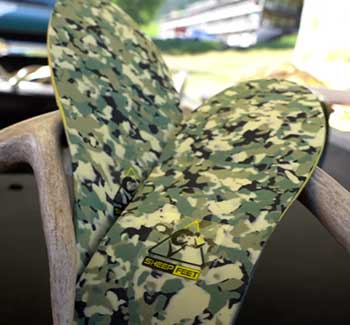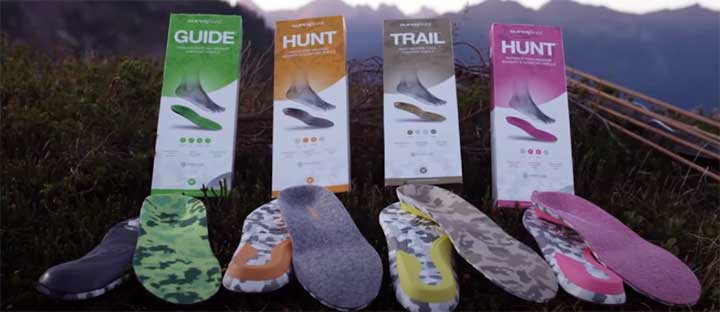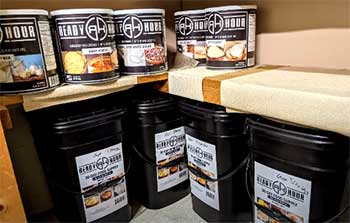If you love hitting the trails but hate how your feet feel after a long day hiking, it may be time to upgrade your footwear insoles. The right insoles can make a world of difference when it comes to arch support, cushioning, and stability over rugged alpine terrain.
Two of the top options for mountain hiking insoles are Sheep Feet and Superfeet. But how do you choose between them?
In this in-depth comparison guide, we’ll analyze the pros, cons, features, and real user experiences of Sheep Feet and Superfeet insoles. We’ll cover how they compare for cushioning, stability, moisture wicking, break-in period, and much more.
Read on for the full breakdown, plus answers to frequently asked questions, to determine which of these two hiking insole brands is best for your needs and feet.
A Brief Comparison Table
| Aspects | Sheep Feet | Superfeet |
| Material | Merino wool | Microfiber, carbon fiber |
| Cushioning | Excellent | Minimal |
| Arch support | Contoured | Very firm |
| Moisture wicking | Excellent | Very good |
| Odor control | Excellent | Very good |
| Break-in period | Minimal | 2+ weeks |
Sheep Feet Insoles: Plush Cushioning Right Out of the Box
Designed with mountain hikers in mind, Sheep Feet insoles aim to provide instant comfort and pain relief right when you slip them into your boots. Their merino wool construction brings key advantages.
Pros of Sheep Feet Insoles

- Superior Cushioning: The merino wool upper conforms to your foot’s shape for customized comfort, while the EVA foam midsole absorbs shock and impact. The instant step-in plushness relieves foot fatigue and pain without any break-in period.
- Moisture Wicking: Merino wool excels at wicking away sweat and moisture to keep your feet drier. This helps minimize painful blisters and hot spots during long hikes.
- Odor Control: The anti-microbial properties of merino wool prevents foot odor buildup after hours on the trail.
- Lightweight Warmth: Merino provides insulation from the cold while remaining lightweight and breathable.
- Machine Washable: Simply remove the insoles and toss them in the washing machine to keep them fresh.
Cons of Sheep Feet Insoles
- Higher Price: The premium merino wool construction comes at a cost, making Sheep Feet one of the more expensive hiking insole options.
- Durability Concerns: Some users note that the cushioning compresses down and loses its bounce over time after extensive use.
- Lacks Stability: The flexible merino wool doesn’t provide the most rigid arch support or stability compared to firmer options.
- Sizing Runs Small: Many users suggest ordering 1/2 or full size up for the best foot fit.
Key Features of Sheep Feet Insoles
- Merino wool upper with EVA foam midsole
- Contoured arch support and deep heel cup
- Shock absorbing metatarsal pad
- Breathable and moisture wicking
- Machine washable
- 1-year manufacturer warranty
The upfront plushness lends to instant relief, especially if you already suffer from foot pain and swelling on hikes. The merino construction brings key advantages like temperature regulation, moisture wicking, and breathability lacking in some other hiking insoles.
Superfeet Insoles: Rigid Support That Lasts
With over 4 decades of experience making insoles, Superfeet has earned a reputation for durable, stabilizing support. Their rigid contoured shape aims to correct alignment and posture for improved shock absorption.
Pros of Superfeet Insoles
- Excellent Arch Support: The firm, contoured shape provides rigid support under the arches to prevent collapse.
- Impact Resistance: The stiff stabilizing cap and heel cup guide the foot through each step, absorbing shock.
- All-Day Comfort: Once broken-in, the sturdy shape provides reliable arch support and comfort mile after mile.
- Custom Options: Superfeet offers different models designed for various foot issues like flat feet, high arches, and pronation.
- Long Lasting: The rigid, non-compressible materials retain their supportive shape for hundreds of miles of rugged use.
Cons of Superfeet Insoles
- Painful Break-In: The ultra-firm, unpadded shape causes significant discomfort until your feet adjust, which can take weeks.
- Minimal Cushioning: Besides a thin foam cover, Superfeet offer little extra cushy shock absorption.
- Sizing Difficulties: Getting the correct size is tricky but imperative for the contoured shape to stabilize properly.
- Expensive: While cheaper than some brands, Superfeet still come at a premium cost, especially for replacing them yearly.
Key Features of Superfeet Insoles
- Firm, contoured shape for arch support
- Carbon fiber stabilizer cap for structure
- Deep heel cup for stability
- Microfiber cover wicks moisture
- Comes in different models by foot type
- Made in the USA
The rigid arch and heel cup aim to position the foot for optimal alignment, shock absorption, and comfort once you make it through the painful break-in period. Then the sturdy shape provides reliable support and stabilization hike after hike.
Direct Comparison of Cushioning & Support

Let’s analyze how the cushioning and support of Sheep Feet and Superfeet hiking insoles stack up:
Cushioning
- Sheep Feet offers superior plush cushioning and shock absorption right out of the box.
- Superfeet has minimal cushioning aside from its thin foam cover.
Arch Support
- Sheep Feet provides moderate arch support that flexes to conform to your foot.
- Superfeet are renowned for their rigid, contoured arch support that never compresses.
Stability
- Sheep Feet offers decent stability but the flexible merino can’t match the rigid shape of Superfeet.
- Superfeet excel at stabilizing and positioning the foot for optimal alignment and posture.
Break-In Comfort
- Sheep Feet cushioning brings instant comfort with no break-in period needed.
- Superfeet are notoriously painful until your feet adjust over weeks.
So in summary, Sheep Feet insoles shine for instant cushioned comfort but can’t match the firm stabilization of Superfeet. It depends whether you prefer flexible cushioned support or rigid stability and alignment correction.
Hiking Insole Breathability & Moisture Wicking Compared
Proper moisture wicking is critical to keep your feet dry and blister-free over endless mountain miles. Here’s how Sheep Feet and Superfeet hiking insoles compare at sweat and moisture management:
- Sheep Feet are highly breathable and excel at moisture wicking thanks to the merino wool upper.
- Superfeet use a microfiber cover that also provides decent moisture wicking abilities.
- The antimicrobial properties of both materials help minimize foot odor after long hours on the trails.
- Sheep Feet insoles can be machine washed, while Superfeet must be air dried.
So while Superfeet offers adequate moisture control, the natural abilities of merino wool give Sheep Feet the edge for keeping your feet drier and more comfortable during strenuous mountain hikes.
Also Read: Differences Between Superfeet Adapt Hike Max And Trailblazer Insoles.
Sheep Feet Or Superfeet: Durability Compared
Serious hikers need insoles that can hold up to hundreds of miles over rough alpine terrain. Here’s how Sheep Feet and Superfeet compare:
- The rigid Superfeet shape retains its supportive contour and stiffness for much greater durability and longevity.
- The flexible merino wool of Sheep Feet starts compressing after extensive use, losing its bounce.
- Superfeet are built to last for several years, while Sheep Feet may need replacing annually with heavy use.
So for uncompromising stability and support over endless miles on the trails, Superfeet are the clear winner for durability. However, some hikers find replacing the Sheep Feet insoles annually worth it for the upfront cushioning and comfort.
Cost Comparison
You’ll pay a premium for both of these high-performing hiking insole brands:
- Sheep Feet Insoles: $40-$60 per pair
- Superfeet Insoles: $40-$50 per pair
Superfeet come in at a slightly lower cost, especially given their longer lifespan. However, some hikers find the plush cushioning and instant comfort of Sheep Feet worth the steeper price.
Which Is Best For Your Feet?
With the key differences laid out, should you choose Sheep Feet or Superfeet insoles for your mountain hiking adventures?
Choose Sheep Feet if you:
- Prioritize soft, cushioned comfort right away
- Need excellent moisture wicking abilities
- Have foot pain issues like plantar fasciitis
- Prefer flexible support over rigid stabilization
Choose Superfeet if you:
- Require firm, stabilized arch support
- Have overpronation or alignment issues
- Want an ultra-durable insole for years of hiking
- Don’t mind a painful break-in period
Both offer quality performance. But in the cushioning vs. support battle, Sheep Feet caters to instant step-in comfort, while Superfeet focuses on foot alignment and stability in the long run.
Consider your specific hiking needs and foot sensitivities as you decide between these two great mountain hiking insole options.
Also Read: Comparison of Darn Tough And WillowAce Hiking Socks.
Hiking Insoles FAQs
Still have some questions? Here we cover some of the key frequently asked questions about Sheep Feet and Superfeet hiking insoles.
For hikers who prioritize cushioned comfort over all else, the plush quality and moisture wicking capabilities of Sheep Feet makes them worth the investment. The merino wool brings temperature regulation and breathability ideal for the trails.
However, more budget-focused hikers find cheaper options like Superfeet provide sufficient support at a lower cost. It comes down to your preferences and sensitivities.
For some hikers, Superfeet gives arch support nearly on par with custom-molded orthotics. The contoured shape targets foot alignment and stability. Those with minor to moderate overpronation or arch issues find the firm Superfeet shape provides adequate correction and pain relief.
But those with severe alignment problems and foot pain may require true custom orthotics formed precisely to match the contours of your feet. In that case, Superfeet makes an excellent over-the-counter option to try before pursuing custom orthotics.
The ultra-firm, contoured material gives Superfeet insoles their renowned supportive rigidity. Unlike cushier insoles, the inflexible shape resists compression over time and rugged miles. This prevents cushioning loss underfoot.
But this rigid construction requires a rough break-in period as your feet adapt. Adding extra sock cushioning can make that transition phase more tolerable until the hard shape feels normal.
Many podiatrists do recommend Superfeet for their rigid, supportive shape. The heel cup, contoured arch, and stabilizer cap help position the foot for proper alignment and posture. This can relieve various foot pain issues when fitted correctly. Those with overpronation or plantar fasciitis often find relief using Superfeet.
However, for serious cases like ruptured arches or plantar fasciitis, custom orthotics molded specifically for your feet may be necessary over any off-the-shelf insole. But many foot doctors suggest giving Superfeet a try first.
Final Thoughts
Don’t underestimate the importance of proper insoles for comfortable, pain-free hiking. Both Sheep Feet and Superfeet make premier options to consider. Sheep Feet provides instant step-in plushness, while Superfeet offers lasting rigid support.
Weigh your needs for cushioning, stability, sweat-wicking, and durability as you decide which brand is the best fit. Why suffer through another painful, blister-filled mountain hike?
Transform your comfort hitting the trails with Sheep Feet or Superfeet keeping each step feeling great.


